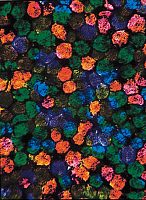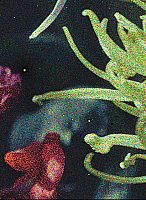What is Autochrome?
“100 Years of Autochrome ” — Tenth exhibition of Šechtl & Voseček Museum of Photography.
The Lumière Autochrome process is often considered to have produced some of the most beautiful and delicate color photographs ever taken. They were not the earliest color photographs — Scottish physicist James Clerk Maxwell had experimented with color photography as early as 1861 — but it was the first industrialized technique of color photography that was easy enough, and with attractive enough results, to be used by ordinary amateur photographers.
The Autochrome process was first patented in France in 1903, with further revisions in 1904, by the Lumière brothers, who are perhaps today better known for their “Cinematograph”, but whose contribution to color photography was no less substantial. Introduced commercially in 1907, Autochromes quickly dominated the market, despite their relatively high price, low sensitivity to light, and lack of a quality method to secure prints. They would remain the preferred method of color photography till the advent of Kodachrome in the 1930’s.
An Autochrome plate consisted of a color mosaic of microscopic grains of potato starch, which had been dyed to 3 primary colors – red-orange, green and blue-violet (Fig 3). This mosaic was covered by a (panchromatic) black and white photographic emulsion, which was sensitive to all colors . The Autochrome plate was placed in the camera with the glass side nearest the lens. When the photograph was taken, the light from the object came through the lens and the glass backing of the Autochrome plate, and was then filtered by the color mosaic. Thus, for example blue-violet-stained grains let blue-violet light through; green-stained grains let green light through; and red-orange-stained grains let red-orange light through . Other colors, made up of mixtures of those primary colors, would allow mixtures of light through. For example brown color is created as a mixture of green and orange. Because the photographic emulsion wasn't sensitive to all colors equally, a yellow filter was used in the front of the lens.
Where light passed through the mosaic filter to the photographic emulsion, after developing, the emulsion at that point would be clear. Where light from the object was filtered out, after developing, the emulsion at that point would be opaque . When the Autochrome was viewed, by back-lighting with a white light, this light would pass through the emulsion layer where it was clear, and then through the stained starch grains, resulting in a view of the image in more-or-less natural color .
While the basic idea behind Autochrome seems very simple, turning the idea into a commercially-viable process was very difficult. The first stage of the process was to prepare three batches of starch grains, of between 5 and 10 microns diameter. The batches were stained respectively red-orange, green, and blue-violet, and then merged into a homogeneous mixture. Next, a glass plate was spread with a mixture of crude pine sap and beeswax, and then coated with a single layer of the starch grains, to create a random color mosaic of the grains. By applying around 5 kg/cm² pressure to the plate during the manufacture of the plate, the starch grains were slightly flattened, thus reducing graininess, and transmitting more light to the emulsion. Lampblack was then applied, to fill the clear spaces between the grains. After this, the plate was coated with shellac, both to protect the color mosaic, and to provide a flat surface for the light-sensitive emulsion, which was spread on the plate once the shellac had dried.
The technological details of producing Autochromes developed over the years, and resulted in improved quality of the photographs. In the early 1930's, a film-based medium, otherwise equivalent to Autochrome, was introduced, and marketed as Filmcolor. Film base also allowed more pressure to be applied during manufacture, thus producing thinner grains which further improved the sensitivity to light. Another improvement, Lumicolor, eliminated the need for a yellow filter in front of the lens, and for lampblack in the mosaic, thus again significantly improving the sensitivity to light. While Filmcolor almost completely replaced glass-plate Autochromes within three years, its success was short-lived, as manufacturers like Kodak began in earnest to produce the multi-layer, subtractive color films (such as Kodachrome, Agfacolor Neu and Kodacolor) which we know today. Filmcolor production ceased in the mid-1930's even though some photographers preferred it over modern films till the 1950's. For example, a book on Czech national costumes by Karel Šmirous, published in 1956, still had all photographs made on Filmcolor.
Author: Jan Hubička
